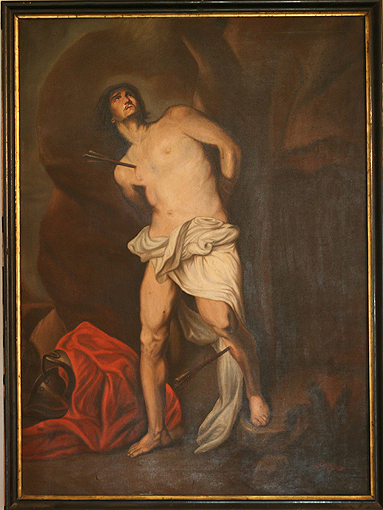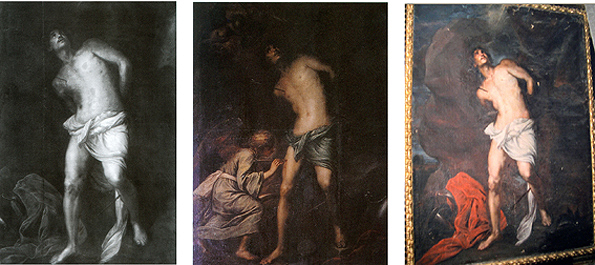The piece of the month of May 2009
A COPY OF THE "MARTYRDOM OF SAINT SEBASTIAN" BY JUAN CARREÑO DE MIRANDA IN THE CISTERCIAN MONASTERY OF TULEBRAS (NAVARRA)
María Josefa Tarifa Castilla
Chair of Navarrese Heritage and Art
In one of the rooms of the Navarrese monastery of Nuestra Señora de la Caridad de Tulebras, the first foundation of the female Cistercian Order in the Peninsula, hangs a painting depicting the Martyrdom of Saint Sebastian (84 x 61 cm).
painting with the representation of the Martyrdom of Saint Sebastian (84 x cm). The canvas reproduces the moment in which this Roman soldier was condemned to die tied to a post in the time of Emperor Diocletian for exhorting his young friends Mark and Marcellinus to remain faithful to their faith in Christ. However, although he served as a living target for the archers who martyred him, he did not die then, recovering from his wounds with the care of the widow Irene.
The painting sample the young soldier tied to the trunk of the tree, naked and motionless, with an anatomical study of great beauty once he has been stripped of his clothes, breastplate and cloak. The sensuality of the flesh and the line of the horizon leave, within the solitude in which the martyr finds himself, with the memory of his recent past by the fallen clothes at his feet, affect a deep dramatism. The painting is signed in the lower right corner under the name "La Gracia. Cop. 1888", so it is a nineteenth century reproduction of a work of renown prior in time, a common internship in this nineteenth century. We lack documentation to clarify if the work was commissioned by the nuns to the artist or if it was donated to the monastery.

"Martyrdom of Saint Sebastian", 1888. Monastery of Tulebras
The canvas is a literal copy of another painting topic by Juan Carreño de Miranda, kept in the Suermondt-Ludwig Museum in Aachen and taken from Spain by the Prussian von Schepeler after participating in the Napoleonic war. Acquired by Suermondt, he donated it to the Museum with the rest of his collection. Pérez Sánchez estimates that it could be the original work for the altar of the church of Saints Justo and Pastor in Madrid (ca. 1660). Likewise, Saint Sebastian is pierced by arrows, although in this case he is accompanied in his agony by two angels, one crowning him on high and the other healing the wound in his right thigh. The saint's body is leaning to the opposite side than in the "Martyrdom of Saint Sebastian" by the same author preserved in the Prado Museum (1656). With an attractive face, he directs his gaze to the sky. The similarities in both paintings, the original by Carreño and the 19th century copy conserved in Tulebras, are more than evident. The saint is pierced by two arrows, in the pectoral and in the left leg; he presents the same accentuated break of the waist, his body being supported by the arms arranged in the back. The clothes rest at the feet of the figure, and the naked body of the young man is only covered by the cloth of purity of similar disposition.
Also sample great similarity the painting of Tulebras with another Martyrdom of Saint Sebastian of the last third of the XVII century, that for a long time was in the conference room capitular of the Cathedral of Tarazona and at the present time it is in the storeroom of the episcopal palace of this locality. It is an oil on canvas, larger than the one kept in the Suermondt-Ludwig Museum in Aachen, and which for some time was attributed to the painter Vicente Berdusán, an authorship rejected by Juan Carlos Lozano, among others. Abbad Ríos, however, related it to the school of Claudio Coello, while Begoña Arrúe again linked it to the style of the Axis painter.

From left to right: "Martyrdom of Saint Sebastian" ( 197 x cm), Juan Carreño de Miranda, Suermondtd-Ludwing Museum, Aachen; "Saint Sebastian" (162 x cm), Santos Justo y Pastor Parish Church, Madrid; "Martyrdom of Saint Sebastian", anonymous, (277 x cm), Tarazona, Episcopal Palace.
Federico Torralba saw it in the chapterhouse conference room of the cathedral of Turiason and said that it had memories of Van Dyck and that it was a work of the Madrid school, within the circle of Carreño. We agree with the opinion of this author, since the canvas takes as its starting point a painting of the same topic by Van Dyck engraved by Lucas Vorsterman the Younger, although in inverted position, coinciding the position of the legs, the sinuous disposition of the body, the left arm backwards and the head tilted and elevated towards the break of glory. In the painting of the cathedral of Tarazona, the saint appears with his hands tied to a tree and tied to the chest and left leg. The right extremity advances towards the spectator and the head is sample with a suffering gesture and in a slight foreshortening to direct the gaze upwards, where a break of glory is insinuated, something very much to the taste of the painters of the time like Mateo Cerezo in his "San Juan Bautista" (Kassel Museum), of great resemblance in the disposition of the body. The martyr covers his waist with a white knotted cloth that falls to his feet, while on the ground are arranged the knight's armor and the red cloak. The background is made up of a large rock -we suspect dirt- that barely allows us to see a natural landscape in the background, an aspect that has even been copied in the Tulebras canvas. Very expressive is the exceptional face of Sebastian, whose undulating body, illuminated with a certain dramatic accent, is of great anatomical perfection.
bibliography
ARRÚE UGARTE, B., Inventario artístico de Zaragoza y su provincia, Tomo I, Partido judicial de Tarazona, Madrid, Ministerio de Cultura, 1991, p. 179.
BUENDÍA, J.R. and GUTIÉRREZ PASTOR, I., Vida y obra del pintor Mateo Cerezo (1637-1666), Burgos, Diputación Provincial, 1986, pp. 93-94.
LÓPEZ VIZCAINO, P. and MARINO CARREÑO, A., Juan Carreño de Miranda. Vida y obra, Cajastur, 2007.
LOZANO LÓPEZ, J.C., El pintor Vicente Berdusán (1632-1697) y Aragón: Catalog razonado, clientela y fuentes gráficas, literarias y devocionales de su pintura, Zaragoza, Universidad de Zaragoza, 2004, p. 346.
RÉAU, L., Iconography of Christian Art. Iconography of the Saints. De la P a la Z, vol. 2, vol. V, Barcelona, Ediciones del Serbal, 2002, pp. 193-103.
TORRALBA SORIANO, F., La Catedral de Tarazona, Col. Monumentos de Aragón, nº. 3, Zaragoza, Institución Fernando el Católico, 1974, p. 58.
VVAA, Las Catedrales de Aragón, Zaragoza, Caja de Ahorros de Zaragoza, Aragón y Rioja, 1987, p. 150.
